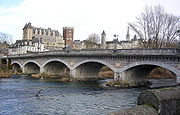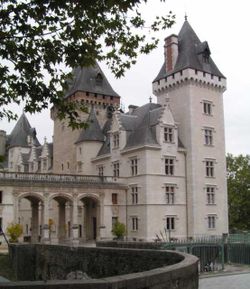
Château de Pau
Encyclopedia


Château
A château is a manor house or residence of the lord of the manor or a country house of nobility or gentry, with or without fortifications, originally—and still most frequently—in French-speaking regions...
de Pau (Pau Castle) is a castle in the centre of Pau, the capital of Pyrénées-Atlantiques
Pyrénées-Atlantiques
Pyrénées-Atlantiques is a department in the southwest of France which takes its name from the Pyrenees mountains and the Atlantic Ocean.- History :...
and Béarn
Béarn
Béarn is one of the traditional provinces of France, located in the Pyrenees mountains and in the plain at their feet, in southwest France. Along with the three Basque provinces of Soule, Lower Navarre, and Labourd, the principality of Bidache, as well as small parts of Gascony, it forms in the...
. King Henry IV
Henry IV of France
Henry IV , Henri-Quatre, was King of France from 1589 to 1610 and King of Navarre from 1572 to 1610. He was the first monarch of the Bourbon branch of the Capetian dynasty in France....
of France
France
The French Republic , The French Republic , The French Republic , (commonly known as France , is a unitary semi-presidential republic in Western Europe with several overseas territories and islands located on other continents and in the Indian, Pacific, and Atlantic oceans. Metropolitan France...
and Navarre
Navarre
Navarre , officially the Chartered Community of Navarre is an autonomous community in northern Spain, bordering the Basque Country, La Rioja, and Aragon in Spain and Aquitaine in France...
was born here on December 13, 1553.
The château is located in the centre of Pau and dominates that quarter of the city. It was once used by Napoleon
Napoleon I of France
Napoleon Bonaparte was a French military and political leader during the latter stages of the French Revolution.As Napoleon I, he was Emperor of the French from 1804 to 1815...
as a holiday home during his period of power. It has a small garden that was tended by Marie Antoinette
Marie Antoinette
Marie Antoinette ; 2 November 1755 – 16 October 1793) was an Archduchess of Austria and the Queen of France and of Navarre. She was the fifteenth and penultimate child of Holy Roman Empress Maria Theresa and Holy Roman Emperor Francis I....
when she spent much of the summer in the city.
The castle is classified as a Monument historique
Monument historique
A monument historique is a National Heritage Site of France. It also refers to a state procedure in France by which national heritage protection is extended to a building or a specific part of a building, a collection of buildings, or gardens, bridges, and other structures, because of their...
since 1840 by the French Ministry of Culture.
The castle nowadays contains a good collection of tapestries.
Origins
Pau Castle was founded in the Middle AgesMiddle Ages
The Middle Ages is a periodization of European history from the 5th century to the 15th century. The Middle Ages follows the fall of the Western Roman Empire in 476 and precedes the Early Modern Era. It is the middle period of a three-period division of Western history: Classic, Medieval and Modern...
. Work before any military, is a castle
Castle
A castle is a type of fortified structure built in Europe and the Middle East during the Middle Ages by European nobility. Scholars debate the scope of the word castle, but usually consider it to be the private fortified residence of a lord or noble...
typically built on top of the hill overlooking the Gave
Gave de Pau
The Gave de Pau is a river of south-western France and a left tributary of the Adour. It takes its name from the city Pau, through which it flows. The river is in length, and its source is at the Cirque de Gavarnie in the Pyrenees mountains....
bounded by ravine Hédas.
Since its construction, the castle takes on a symbolic importance: providing a stockade (poor, in Bearn) designate, by metonymy
Metonymy
Metonymy is a figure of speech used in rhetoric in which a thing or concept is not called by its own name, but by the name of something intimately associated with that thing or concept...
, the city itself. These piles, symbolizing loyalty and righteousness, are each asaxis mundiin a version of béarnaise. In the twelfth century Gaston IV of Béarn
Gaston IV of Béarn
Gaston IV was viscount of Béarn from 1090 to 1131. He was called "le Croisé" due to his participation in the First Crusade....
built three towers at the fortress. They are called Mazères
Mazères-Lezons
Mazères-Lezons is a commune in the Pyrénées-Atlantiques department in south-western France.-References:*...
Billère
Billère
Billère is a commune in the Pyrénées-Atlantiques department in south-western France.-References:*...
and Montauser.
Gaston Phoebus
The fourteenth century will see a figure emblematic of Bearn, who leaves his mark at the Chateau de Pau: Gaston III of Foix-BéarnGaston III of Foix-Béarn
Gaston III/X of Foix-Béarn, also Gaston Fébus or Gaston Phoebus was the 11th count of Foix, and viscount of Béarn . Officially, he was Gaston III of Foix and Gaston X of Béarn.-Early life:...
, better known as the'Gaston Phoebus. This warlord, in a difficult position because, by their possessions, under the leadership of the enemy kingdoms of France and England, makes the Beam, "gift of God," a united and autonomous region. Fébus there built the tower of brick, high thirty-three meters, and it burns the inscription:feFebus me "(" Phoebus gave me, in Bearn).
The kings of Navarre
At the Renaissance, installation of the court of NavarreLower Navarre
Lower Navarre is a part of the present day Pyrénées Atlantiques département of France. Along with Navarre of Spain, it was once ruled by the Kings of Navarre. Lower Navarre was historically one of the kingdoms of Navarre. Its capital were Saint-Jean-Pied-de-Port and Saint-Palais...
in 1512, significantly alters the appearance of the castle. Fortress it was originally, it becomes a pleasure residence. Henri d'Albret resides with his wife Marguerite d'Angoulême, sister of François I
Francis I of France
Francis I was King of France from 1515 until his death. During his reign, huge cultural changes took place in France and he has been called France's original Renaissance monarch...
, most known for Marguerite de Navarre
Marguerite de Navarre
Marguerite de Navarre , also known as Marguerite of Angoulême and Margaret of Navarre, was the queen consort of Henry II of Navarre...
, author of The Heptaméron . They mark the place of their initials, present on the walls and ceilings, and that care was taken to maintain and reproduce over the subsequent restorations.
Henri IV
But their grand-son who gives the famous castle it is today: not by any architectural endeavor, nor even by his own will. The future Henri IVHenry IV of France
Henry IV , Henri-Quatre, was King of France from 1589 to 1610 and King of Navarre from 1572 to 1610. He was the first monarch of the Bourbon branch of the Capetian dynasty in France....
takes the trouble to be born December 13, 1553, and the story did the rest. The fame of the king, baby boy cradled in a turtle shell preserved by the Béarn through the vicissitudes of revolutions, gives the castle, which did not see him grow up or die, a particular taste, and the right to claim honors those who give birth supermen. But the real recognition of the king is posthumous, and we soon forgot the castle that he was born, except to gather Navarre and Bearn in the kingdom of France (Louis XIII y signed the treaty in 1620).
The Restoration
Louis-Philippe, which would combine the ideals of the RevolutionFrench Revolution
The French Revolution , sometimes distinguished as the 'Great French Revolution' , was a period of radical social and political upheaval in France and Europe. The absolute monarchy that had ruled France for centuries collapsed in three years...
and those of the monarchy, had the idea of restoring the castle of the man who reconciled Catholic
Catholicism
Catholicism is a broad term for the body of the Catholic faith, its theologies and doctrines, its liturgical, ethical, spiritual, and behavioral characteristics, as well as a religious people as a whole....
and Protestant
Protestantism
Protestantism is one of the three major groupings within Christianity. It is a movement that began in Germany in the early 16th century as a reaction against medieval Roman Catholic doctrines and practices, especially in regards to salvation, justification, and ecclesiology.The doctrines of the...
into a royal residence. Reside there, however.
The castle was mostly gilded prison in 1848 the emir Abd El-Kader, conquered by France Algeria
Algeria
Algeria , officially the People's Democratic Republic of Algeria , also formally referred to as the Democratic and Popular Republic of Algeria, is a country in the Maghreb region of Northwest Africa with Algiers as its capital.In terms of land area, it is the largest country in Africa and the Arab...
. As might be that this castle should retain its character Henricians, placed there many objects neo-Renaissance and neo-Gothic and a magnificent collection of tapestries (16th - 19th century), to recall the halcyon days of good King. Louis-Philippe, in exile in England, could never stay at this place which was visited by Napoleon III. He is the Renaissance portal through which one enters and who bears the initials of the royal couple of Navarre, founder of the modern castle.
Today, the National Museum
Then the castle became a presidential residence in the Republic. He is currently a National Museum which houses the works preserved from the days of Henry IV and especially during the restoration made by Louis Philippe. The collections are increasing every year around the theme Henricians. It currently hosts over 100,000 visitors annually, making it the most visited heritage site of Pyrénées-AtlantiquesPyrénées-Atlantiques
Pyrénées-Atlantiques is a department in the southwest of France which takes its name from the Pyrenees mountains and the Atlantic Ocean.- History :...
.

